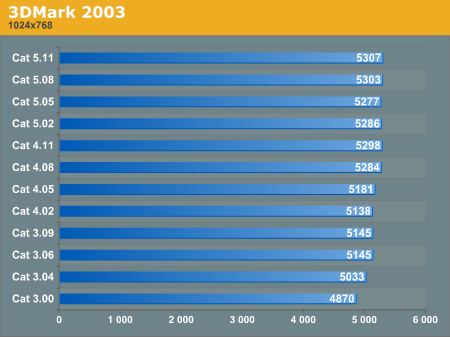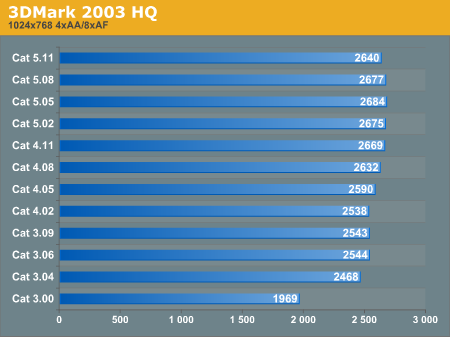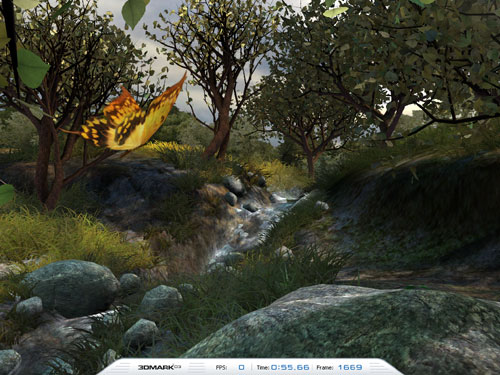Looking Back: ATI's Catalyst Drivers Exposed
by Ryan Smith on December 11, 2005 3:22 PM EST- Posted in
- GPUs
3dMark 2003
3dMark is not a benchmark that we routinely bring you here at AnandTech, as our editorial policy is to bring you benchmarks from real-world games and engines, and not synthetic metrics. That said, it would be inappropriate to leave out 3dMark in this case due to the significant cheating incidents with it. And, as a flashy, system draining benchmark backed by a unique database for comparisons, it's still an important title in the eyes of many consumers, OEMs, and the GPU makers looking for bragging rights.
With 3dMark, its importance in this regression is not so much the performance improvements as a sign of what happened with the card - the improvements were most certainly exaggerated due to in part by the synthetic nature of the benchmark - but rather a possibility of what can happen when ATI dedicates its resources to a game/benchmark that it considers most important. We should note that ATI has admitted to "cheating" on 3dMark 2003; however, these were what we consider honest shader-replacement optimizations (same mathematical output) that ATI voluntarily removed, though they were apparently re-introduced at some point. We used the latest version of 3dMark 2003, so this "cheat" was not activated in the older drivers.
For these benchmarks, 3dMark was run at its default resolution of 1024x768.
Overall then, 3dMark is much like Halo, a benchmark that received a slow, but steady improvement, without any fixes.
3dMark is not a benchmark that we routinely bring you here at AnandTech, as our editorial policy is to bring you benchmarks from real-world games and engines, and not synthetic metrics. That said, it would be inappropriate to leave out 3dMark in this case due to the significant cheating incidents with it. And, as a flashy, system draining benchmark backed by a unique database for comparisons, it's still an important title in the eyes of many consumers, OEMs, and the GPU makers looking for bragging rights.
With 3dMark, its importance in this regression is not so much the performance improvements as a sign of what happened with the card - the improvements were most certainly exaggerated due to in part by the synthetic nature of the benchmark - but rather a possibility of what can happen when ATI dedicates its resources to a game/benchmark that it considers most important. We should note that ATI has admitted to "cheating" on 3dMark 2003; however, these were what we consider honest shader-replacement optimizations (same mathematical output) that ATI voluntarily removed, though they were apparently re-introduced at some point. We used the latest version of 3dMark 2003, so this "cheat" was not activated in the older drivers.
For these benchmarks, 3dMark was run at its default resolution of 1024x768.



Catalyst 5.11 versus 3.00 (mouse over to see 3.00)
Overall then, 3dMark is much like Halo, a benchmark that received a slow, but steady improvement, without any fixes.










58 Comments
View All Comments
Ryan Smith - Sunday, December 11, 2005 - link
You should see the cooler attached, it sure sounds like a 757.Anyhow, good catch, thanks.
ss284 - Sunday, December 11, 2005 - link
I think this article might have been a bit more meaningful if some newer generation games were tested, like half life 2 and far cry.ElJefe - Sunday, December 11, 2005 - link
lol yes I thought the same.I was like eh? bf2 and half-life2 and doom3. Or quake 4 maybe. ( even though most gamers are not on that bandwagon yet, bf2 for first person is kinda king still)
Cygni - Tuesday, December 13, 2005 - link
Older drivers are going to have issues with newer games. Thats whats talked about in the article. If you are running Cat 1.0's with FEAR, its going to go ape shit... FEAR wasnt even around when those drivers came out. By using older games, they can limit this factor and make it a pure perforamnce comparison.ksherman - Sunday, December 11, 2005 - link
:(vshah - Sunday, December 11, 2005 - link
Mouseover makes the first image dissapear for me in firefox and ie.Will there be an nvidia version of this?
kerynitian - Monday, December 12, 2005 - link
I would definitely be interested in seeing how nvidida and their driver improvements in the nv40 line related to the marks put up by ati in this article...coldpower27 - Sunday, December 11, 2005 - link
Yes it might be interesting to do one with a 6800 GT/Ultra, to see if there have been improvements of extracting performance out of NV40 technology over the past now 18 months of life.I think we were in the early 61.xx when NV40 came out?
nts - Monday, December 12, 2005 - link
With this article testing on the R300 they would probably test NVIDIA NV30 (FX) cards.coldpower27 - Sunday, December 11, 2005 - link
Actually I beleive that is ~ 20 months instead of 18.